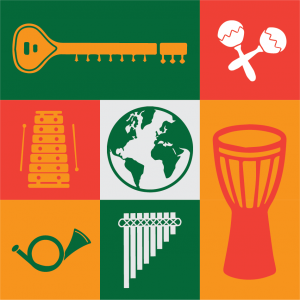Pow Wow Music in Canada

Overview
Indigenous music in North America comes from many cultures, regions, traditions, and languages. Although there is some variation in its practices and functions, traditional music is relatively homogeneous among large regions in Canada and the United States: it is mostly based on songs accompanied by percussion, sections that are relatively short and repeated, monophonic singing, a vast repertoire of chants (singing without words), and with strong connections to the natural world, spirituality, and dance. However, details differ between geographical areas based on language families in Canada, with repertoire and some stylistic qualities unique to smaller tribes.
The pow wow is an excellent example of Indigenous drumming, songs, and dance. It is an intertribal event that celebrates unity and diversity, and is an affirmation of identities among Indigenous communities. It has a shared repertory of chants without words, allowing diverse communities to participate since there is no specific language required. Different drum groups also perform in a similar singing style. The music is sung by men and women at the same time, and includes a big drum played by multiple men in mostly synchronous pulses. Women stand at the perimeter as the drum’s protectors. Pow wows are flexible in terms of repertoire with a mix of traditional and new compositions to accompany both traditional and modern dances. Many kinds of songs are sung at pow wows including a Grand Entry and Flag Song at the beginning of the event, followed by a number of songs geared to particular stories and dances.
Musicians
All Nation Juniors Traditional Drum Group
The All Nation Juniors Traditional Drum Group performs Indigenous songs and drumming in a variety of settings including Pow Wows and Sun Dance ceremonies. Led by Kevin Myran at the Toronto Council Fire Native Cultural Centre, the group includes youth and young adults who play traditional songs and new compositions by its members. They meet weekly to practice, and frequently perform for community functions and Indigenous ceremonies in Southern Ontario. They are also the official drum group for the American Indian Movement (AIM) chapter in Ontario, and the Thunderbird Lodge drum group for Sun Dance.
Terminology
An understanding of the following terms would be helpful before proceeding with the Video Content.
- Tobacco offering
- Pow wow
- Lead singer
- Grand Entry
- Big drum
- Grass Dance
- Crow Hop
- Sun Dance
- Flag Song
- Honour beats
- Jingle Dress song
- Sneak Up Dance
- American Indian Movement
Video Content
Kevin describes a selection of typical songs at a pow wow which are demonstrated by the drum group. We see and hear the connections between songs and their stories and dances, with discussion of the roles of men and women, and how the songs are constructed and learned. Kevin often articulates the importance of community, the strong cultural roots of the music, and its political significance with a history of censorship and survival of knowledge, customs and performance practices.
Transcript: Pow Wow Music in Canada
Video Time Cues
- 0:06 Self-introduction and tobacco offering
- 2:17 Grand Entry song
- 5:55 Explanation and story of the big drum
- 11:12 Song demonstration
- 14:50 Explanation of other types of drums
- 15:44 Drums, hiding ceremonies, and gender roles
- 19:15 Story of the pow wow/role of the drum
- 23:18 Grass Dance song before the Grand Entry
- 27:10 Drums and sticks from this drum group
- 30:52 Learning and example repertoire of songs
- 32:26 Structure of a pow wow song/drumming technique
- 34:38 Crow Hop song demonstration
- 38:13 Explanation of the Sun Dance
- 40:55 Grand Entry flags and Flag Song demonstration
- 46:44 Drumming styles and honour beats
- 49:19 Roles of singers and drummers
- 55:00 Description of differences between songs
- 1:00:20 Social conduct among drummers
- 1:01:53 Singing/drumming function in the community
- 1:04:37 Story/demonstration of a new Crow Hop song
- 1:08:48 How the new song was collectively composed
- 1:10:10 Singing chants vs. using language
- 1:10:48 Jingle Dress song, story and performance
- 1:15:24 Sneak Up Dance, story and song
- 1:19:37 War dances: Grass Dance
- 1:28:28 New composition with words by Jayden Wemigwans
- 1:31:27 Jayden describes the song
- 1:33:43 AIM Song description and performance
- 1:41:38 Members of the drum group
Suggested Activities and Assessments
Terms
Create a limited-access wiki of the terms and their definitions listed in the Terminology section above. Students can work individually to create their own “wiki” as text files, or in teams (e.g., through a course website). Students research the meanings, and if relevant, the history of these terms.
Participation
Participatory activities may not always be appropriate for the classroom. Indigenous cultures—especially musical practices—have a long history of impersonation and stereotyping.
- Game show: Quiz
What dance is this?
The instructor plays a different songs performed in the video along with a short description of their context (i.e., for a Grand Entry, Flag Song, Crow Hop, Jingle Dress, Sneak Up, or Grass Dance). Students identify which dances they belong to, and explain why they came to that decision. - Debate
The All Nation Juniors Traditional Drum Group shows us the importance of music for community building. In what other communities does music function the same? How does that compare to Indigenous music in Canada?
Research
Assign students to research one of eight geographical regions in Canada: 1) Northwest Coast, 2) Western Subarctic, 3) Plateau, 4) Plains, 5) Eastern Nomadic, 6) Eastern Sedentary, 7) Maritime, and 8) Arctic. How does traditional music from the assigned area compare to the pow wow music in this video? Students will post their answers in an online discussion forum, and complete a review of another posting from a different assigned region. Students are graded on their original research and the peer review.
